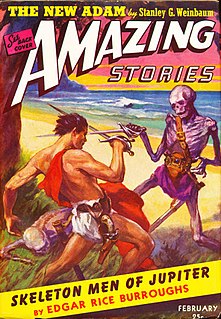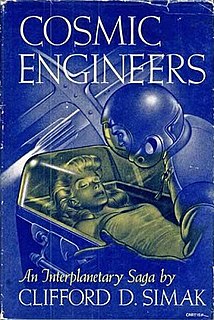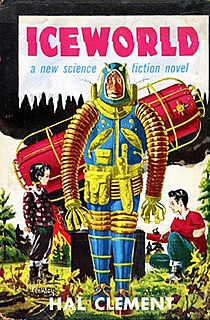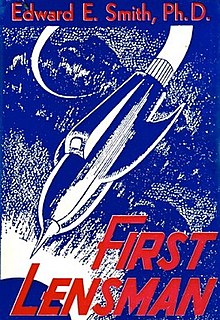Mars, the fourth planet from the Sun, has appeared as a setting in works of fiction since at least the mid-1600s. It became the most popular celestial object in fiction in the late 1800s as the Moon was evidently lifeless. At the time, the predominant genre depicting Mars was utopian fiction. Contemporaneously, the mistaken belief that there are canals on Mars emerged and made its way into fiction. The War of the Worlds, H. G. Wells' story of an alien invasion of Earth by sinister Martians, was published in 1897 and went on to have a large influence on the science fiction genre. Life on Mars appeared frequently in fiction throughout the first half of the 1900s. Apart from enlightened as in the utopian works from the turn of the century or evil as in the works inspired by Wells, intelligent and human-like Martians also began to be depicted as decadent, a portrayal that was popularized by Edgar Rice Burroughs in the Barsoom series. Besides these, more exotic lifeforms appeared in stories like Stanley G. Weinbaum's "A Martian Odyssey". The theme of colonizing Mars replaced stories about native inhabitants of the planet in the second half of the 1900s following emerging evidence of the planet being inhospitable to life, eventually confirmed by data from Mars exploration probes. Terraforming Mars to enable human habitation has been another major theme, especially since the 1990s. Stories of the first human mission to Mars appeared throughout the 1990s in response to the Space Exploration Initiative. The moons of Mars—Phobos and Deimos—have made only sporadic appearances in fiction.

Science fiction is a genre of speculative fiction which typically deals with imaginative and futuristic concepts such as advanced science and technology, space exploration, time travel, parallel universes, extraterrestrial life, sentient artificial intelligence, cybernetics, certain forms of immortality, and the singularity. It has been called the "literature of ideas", and it often explores the potential consequences of scientific, social, and technological innovations.

Glen David Brin is an American scientist and author of science fiction. He has won the Hugo, Locus, Campbell and Nebula Awards. His novel The Postman was adapted into a 1997 feature film starring Kevin Costner.

Unknown was an American pulp fantasy fiction magazine, published from 1939 to 1943 by Street & Smith, and edited by John W. Campbell. Unknown was a companion to Street & Smith's science fiction pulp, Astounding Science Fiction, which was also edited by Campbell at the time; many authors and illustrators contributed to both magazines. The leading fantasy magazine in the 1930s was Weird Tales, which focused on shock and horror. Campbell wanted to publish a fantasy magazine with more finesse and humor than Weird Tales, and put his plans into action when Eric Frank Russell sent him the manuscript of his novel Sinister Barrier, about aliens who own the human race. Unknown's first issue appeared in March 1939; in addition to Sinister Barrier, it included H. L. Gold's "Trouble With Water", a humorous fantasy about a New Yorker who meets a water gnome. Gold's story was the first of many in Unknown to combine commonplace reality with the fantastic.

Jack Dann is an American writer best known for his science fiction, an editor and a writing teacher, who has lived in Australia since 1994. He has published over seventy books, in the majority of cases as editor or co-editor of story anthologies in the science fiction, fantasy and horror genres. He has published nine novels, numerous shorter works of fiction, essays and poetry and his books have been translated into thirteen languages. His work, which includes fiction in the science fiction, fantasy, horror, magical realism and historical and alternative history genres, has been compared to Jorge Luis Borges, Roald Dahl, Lewis Carroll, J.G. Ballard, and Philip K. Dick.

Jupiter, the largest planet in the Solar System, has appeared in works of fiction across several centuries. The way the planet has been depicted has evolved as more has become known about its composition; it was initially portrayed as being entirely solid, later as having a high-pressure atmosphere with a solid surface underneath, and finally as being entirely gaseous. It was a popular setting during the pulp era of science fiction. Life on the planet has variously been depicted as identical to humans, larger versions of humans, and non-human. Non-human life on Jupiter has been portrayed as primitive in some works and more advanced than humans in others.

Robert Paul Holdstock was an English novelist and author best known for his works of Celtic, Nordic, Gothic and Pictish fantasy literature, predominantly in the fantasy subgenre of mythic fiction.
Pluto was discovered in 1930 and has made several appearances in fiction since. It was initially popular as it was newly discovered and thought to be the outermost object of the Solar System. Alien life, sometimes intelligent life and occasionally an entire ecosphere, is a common motif in fictional depictions of Pluto.

The term insectoid denotes any creature or object that shares a similar body or traits with common earth insects and arachnids. It has use in technology, ufology, and other media.
Gender has been an important theme explored in speculative fiction. The genres that make up speculative fiction (SF), science fiction, fantasy, supernatural fiction, horror, superhero fiction, science fantasy and related genres, have always offered the opportunity for writers to explore social conventions, including gender, gender roles, and beliefs about gender. Like all literary forms, the science fiction genre reflects the popular perceptions of the eras in which individual creators were writing; and those creators' responses to gender stereotypes and gender roles.

Earthman's Burden is a collection of science fiction stories by American writers Poul Anderson and Gordon R. Dickson. It was first published by Gnome Press in 1957. The story "Don Jones" was original to this collection. The other stories originally appeared in the magazines Other Worlds, Universe and Fantasy and Science Fiction.

Immortality is a common theme in fiction. The concept has been depicted since the Epic of Gilgamesh, the oldest known work of fiction. Originally appearing in the domain of mythology, it has later become a recurring element in the genres of horror, science fiction, and fantasy. For most of literary history, the dominant perspective has been that the desire for immortality is misguided, albeit strong; among the posited drawbacks are ennui, loneliness, and social stagnation. This view was challenged in the 20th century by writers such as George Bernard Shaw and Roger Zelazny. Immortality is commonly obtained either from supernatural entities or objects such as the Fountain of Youth or through biological or technological means such as brain transplants.

Pattern for Conquest is a science fiction novel by American writer George O. Smith. It was published in 1949 by Gnome Press Reprinted circa 1952 in paper wrappers for distribution to US military personnel. Although a later printing, the first edition statement is retained on the copyright page. [Currey] isfdb Currey

Cosmic Engineers is a science fiction novel by American author Clifford D. Simak. It was published in 1950 by Gnome Press in an edition of 6,000 copies, of which 1,000 were bound in paperback for an armed forces edition. The novel was originally serialized in the magazine Astounding in 1939.

Iceworld is a science fiction novel by American writer Hal Clement. It was published in 1953 by Gnome Press in an edition of 4,000 copies. The novel was originally serialized in the magazine Astounding in 1951.

The Philosophical Corps is science fiction novel by American writer Everett B. Cole. It was published in 1962 by Gnome Press in an edition of 4,000 copies. The novel is a fix-up of stories that originally appeared in the magazine Astounding SF.

The Book of Ptath is a science fiction novel by Canadian-American writer A. E. van Vogt. It was first published in book form in 1947 by Fantasy Press in an edition of 3,021 copies. The novel was originally serialized in the magazine Unknown in October 1943. The book has also appeared under the titles Two Hundred Million A.D. and Ptath.

First Lensman is a science fiction novel and space opera by American author E. E. Smith. It was first published in 1950 by Fantasy Press in an edition of 5,995 copies. Although it is the second novel in the Lensman series, it was the sixth written. The novel chronicles the founding of the Galactic Patrol by Virgil Samms, the first sentient being in our cosmos to wear the "Lens", a unique badge of authority which is actually a form of "pseudo-life" that grants telepathic powers to the defenders of Civilization.

Man of Many Minds is a science fiction novel by American writer E. Everett Evans. It was first published in 1953 by Fantasy Press in an edition of 3,558 copies. The book includes an introduction by E. E. Smith.

The Mightiest Machine is a science fiction novel by American writer John W. Campbell, Jr. The novel was originally serialized in 5 parts in Astounding Stories magazine from December 1934 to April 1935, and was published in book form in 1947 by The Hadley Publishing Co. in an edition of 1,200 copies. Campbell was a leading figure in the Golden Age of Science Fiction.

















